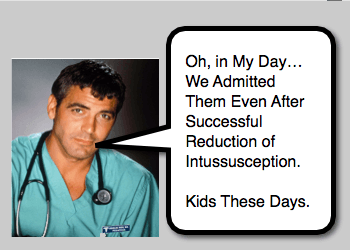Intussusception Discharge
The Ped EM Morsels have discussed several medical myths (ex, Atropine, Morphine for Appendicitis, IV Fluids for rehydration), but remember that “myths” were not born from madness. Previously, physicians were not maliciously inventing erroneous plans; they were doing what was deemed most appropriate based on the available information. This, thus, means that it is incumbent upon all of us to continually reassess management strategies as newer data becomes available. Along that line of thinking, let us consider the appropriate disposition of a child with intussusception: Intussusception Discharge from the ED to Home.
Intussusception Basics
- We have previously discussed some of the basic concepts of pediatric intussusception.
- We have also covered that the diagnosis of intussusception can be challenging and associated with other conditions.
- Intussusception is the most common cause of gastrointestinal obstruction in children.
- Abdominal pain is the most common complaint in children with intussusception. [Mandeville, 2012]
- Once diagnosed, Hydrostatic / Pneumatic Reduction is first choice to treat.
- Air enema or saline enema success rates reported as 80 to 95%
- Should not be done if there is concern for bowel perforation.
- Occasionally, surgical intervention is required if:
- Evidence of peritonitis / Free air present / Patient clinically unstable
- Hydrostatic/pneumatic reduction unsuccessful
- Pathologic lead point present
- Multiple recurrences of intussusception
Intussusception Recurrence
- Recurrence rates after successful reduction:
- Overall: 5-15%. [Beres, 2014; Whitehouse, 2010]
- In the first 24 hours: 2-5%. [Gray, 2014; Chien, 2013]
- In the first 48 hours: 2-5%. [Gray, 2014; Chien, 2013]
- The recurrence rates do not differ significantly between those children discharged from the ED and those who were hospitalized. [Beres, 2014; Whitehouse, 2010]
Intussusception Disposition
- Historically, after successful reduction a patient would be hospitalized to monitor for:
- Possible recurrence
- Possible complication of the reduction
- Possible ischemic changes of the intussusceptum via serial exams
- How long is long enough though? – 6hrs? “Overnight?” 24 hours? 48 hours?
- The practice variance for disposition amongst hospitals is vast:
- For patients successfully reduced the percent discharged the same day ranged from 0% to 83.8%. [Rice-Townsend, 2012]
- Overall rate of same day discharge after successful reduction was 15.2%. [Rice-Townsend, 2012]
- The practice variance for disposition amongst hospitals is vast:
- Based on low recurrence rates and low rates of complications, many are recommending discharge from the ED following successful reduction. [Raval, 2015; Beres, 2014; Whitehouse, 2010]
- Whitehouse, 2010 proposed discharging patients after successful reduction if:
- Patient is afebrile
- Patient is hemodynamically stable
- Patient is tolerating oral hydration (requires period of observation in the ED).
- Additional considerations should include:
- Patient should be pain-free
- Patient requires good social situation and easy access to transportation
- Whitehouse, 2010 proposed discharging patients after successful reduction if:
Moral of the Morsel
- There is evidence to support a change in some of our practice… or at least a prospective study evaluating the safety of discharge from the ED .
- Recurrence happens, but hospitalization does not appear to alter the rate of recurrence or the rate of complications.
- The management of intussusception is multi-disciplinary and it is necessary for us to understand how the surgeons and radiologists interpret this data.
- If your local practice is to discharge appropriate patients after successful reduction, ensure you have a system to reinforce appropriate anticipatory guidance and return precautions.
References
Raval MV1, Minneci PC2, Deans KJ2, Kurtovic KJ3, Dietrich A4, Bates DG5, Rangel SJ6, Moss RL2, Kenney BD2. Improving Quality and Efficiency for Intussusception Management After Successful Enema Reduction. Pediatrics. 2015 Nov;136(5):e1345-52. PMID: 26459654. [PubMed] [Read by QxMD]
Beres AL1, Baird R2, Fung E3, Hsieh H1, Abou-Khalil M1, Ted Gerstle J3. Comparative outcome analysis of the management of pediatric intussusception with or without surgical admission. J Pediatr Surg. 2014 May;49(5):750-2. PMID: 24851762. [PubMed] [Read by QxMD]
Gray MP1, Li SH2, Hoffmann RG2, Gorelick MH3. Recurrence rates after intussusception enema reduction: a meta-analysis. Pediatrics. 2014 Jul;134(1):110-9. PMID: 24935997. [PubMed] [Read by QxMD]
Chien M1, Willyerd FA, Mandeville K, Hostetler MA, Bulloch B. Management of the child after enema-reduced intussusception: hospital or home? J Emerg Med. 2013 Jan;44(1):53-7. PMID: 22555056. [PubMed] [Read by QxMD]
Rice-Townsend S1, Chen C, Barnes JN, Rangel SJ. Variation in practice patterns and resource utilization surrounding management of intussusception at freestanding Children’s Hospitals. J Pediatr Surg. 2013 Jan;48(1):104-10. PMID: 23331801. [PubMed] [Read by QxMD]
Mandeville K1, Chien M, Willyerd FA, Mandell G, Hostetler MA, Bulloch B. Intussusception: clinical presentations and imaging characteristics. Pediatr Emerg Care. 2012 Sep;28(9):842-4. PMID: 22929138. [PubMed] [Read by QxMD]
Whitehouse JS1, Gourlay DM, Winthrop AL, Cassidy LD, Arca MJ. Is it safe to discharge intussusception patients after successful hydrostatic reduction? J Pediatr Surg. 2010 Jun;45(6):1182-6. PMID: 20620317. [PubMed] [Read by QxMD]
Bajaj L1, Roback MG. Postreduction management of intussusception in a children’s hospital emergency department. Pediatrics. 2003 Dec;112(6 Pt 1):1302-7. PMID: 14654601. [PubMed] [Read by QxMD]



[…] are extensive and diverse. We have discussed many of these causes from acute (ex, appendicitis, intussusception, pancreatitis) to chronic (ex, CRAP). We have also discussed causes that don’t reside in the […]
[…] reading: Intussusception Discharge (Pediatric EM […]
[…] Fox tells us we may not need to admit all children with intussusception after successfully reduced. […]